By Candace Fallon, Senior Endangered Species Conservation Biologist
Whenever someone asks me why I’m visiting southern Arizona in the summer, and I tell them it’s for firefly surveys, they look at me blankly. Fireflies? Here? No way. In the desert? No. East Coast, sure. Midwest, absolutely. But Arizona?
Perhaps Arizona is not the first place that pops into your mind when you think of fireflies, either. But there are actually quite a few populations of firefly species scattered throughout the state’s deserts, grasslands, shrublands, wetlands, streams, and woodlands. In total, nearly 20 species have been documented from the state, including not just day-active fireflies and glow-worms, but flashing species as well. This is the part that stuns most people: flashing fireflies are very much a part of Arizona’s wildlife—you just need to be at the right place at the right time to see them.
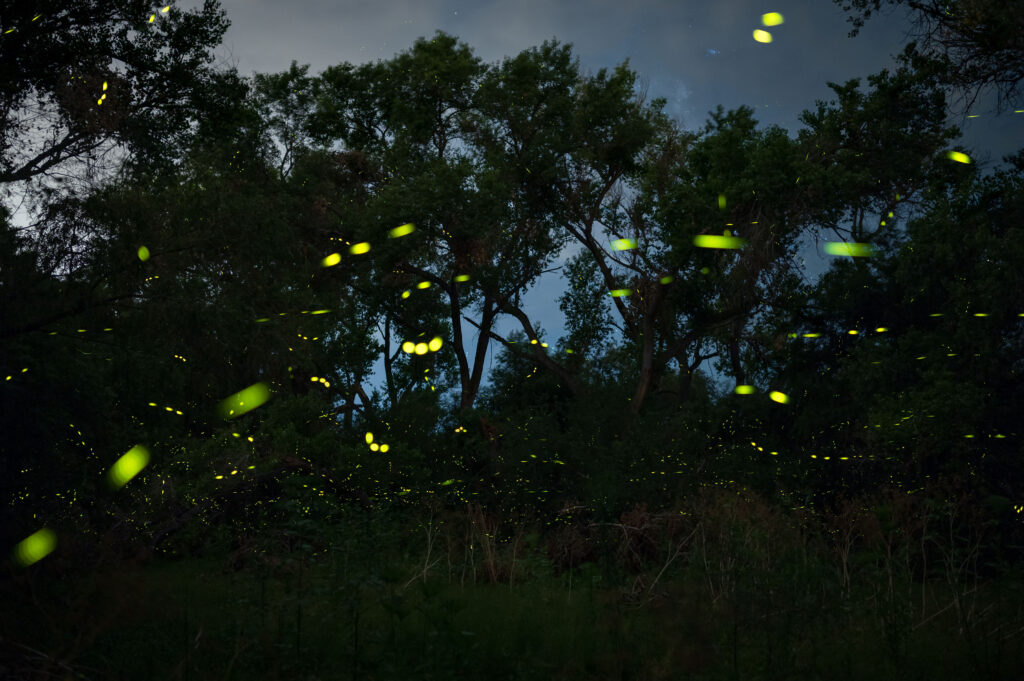

LINK: Julius Schlosburg
To be fair, even firefly researchers didn’t realize how widespread some of these species were until relatively recently. When Xerces and our partners published the first North American firefly IUCN Red List assessments (a process that helps us determine each species’ extinction risk) in 2021, we had limited information on many species’ distributions, life histories, activity periods, population statuses, and threats. Using what we did know, we concluded that at least two Arizona species were threatened with extinction (including one with two threatened subspecies) and two appeared to be stable. The rest were all categorized as Data Deficient, meaning we didn’t have enough information to accurately assess their risk. However, we suspect that several of these are also imperiled, and will be categorized as threatened in the future.
LINK: IUCN Red List assessments
This pattern of data deficiency is not unique to Arizona – a similar scenario played out over many other states, especially in the West. It’s a large part of why we launched the Firefly Atlas, so we could begin to fill in the gaps in our knowledge, and gain a better understanding of where these species occurred on the landscape. If you have done Atlas surveys in Arizona, you’ll know that the southern part of the state is a focal region for the project, centered on three species in particular: the Southwest spring and Southwest synchronous fireflies (both considered threatened) and the twice-wounded firefly, a day-active species that we know very little about but suspect is threatened. In addition to these, we continue to search for a number of other data deficient species, such as Microphotus and Prolutacea glow-worms.
For the last three summers, I’ve had the opportunity to return to the desert Southwest to search for some of these species. While every trip is different, one thing has remained the same: there is a lot to discover in Arizona, and there’s a growing community of firefly enthusiasts and conservationists that is helping to lead the charge. Here are just a few highlights from the 2024 field season.
July 3, 2024. Target species: Southwest spring firefly (Bicellonycha wickershamorum) and pulsating firefly (Prolutacea pulsator)
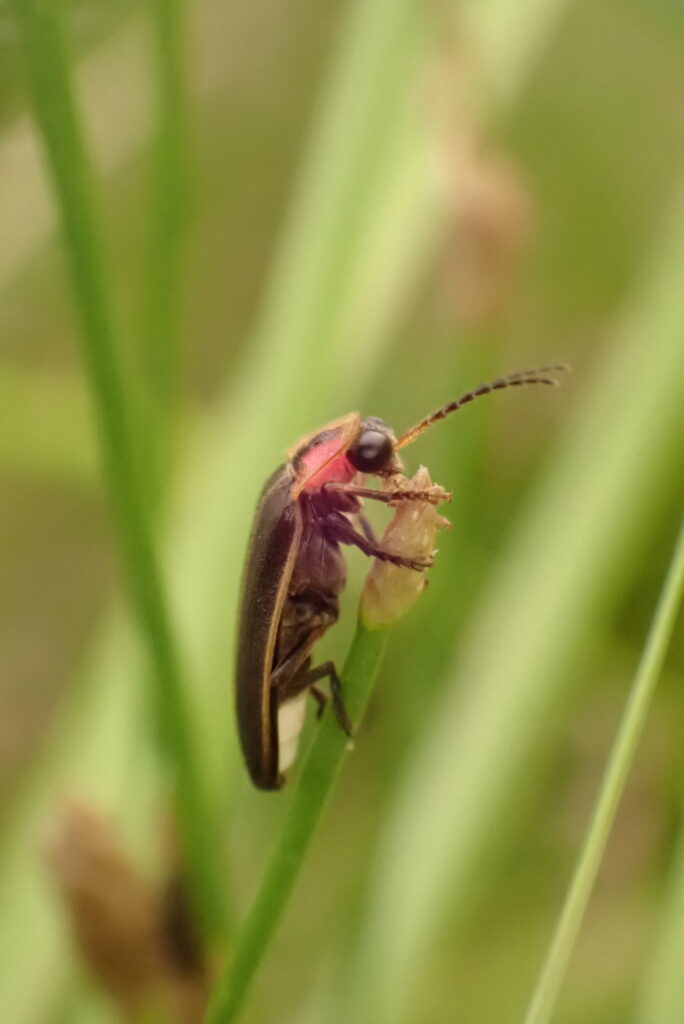

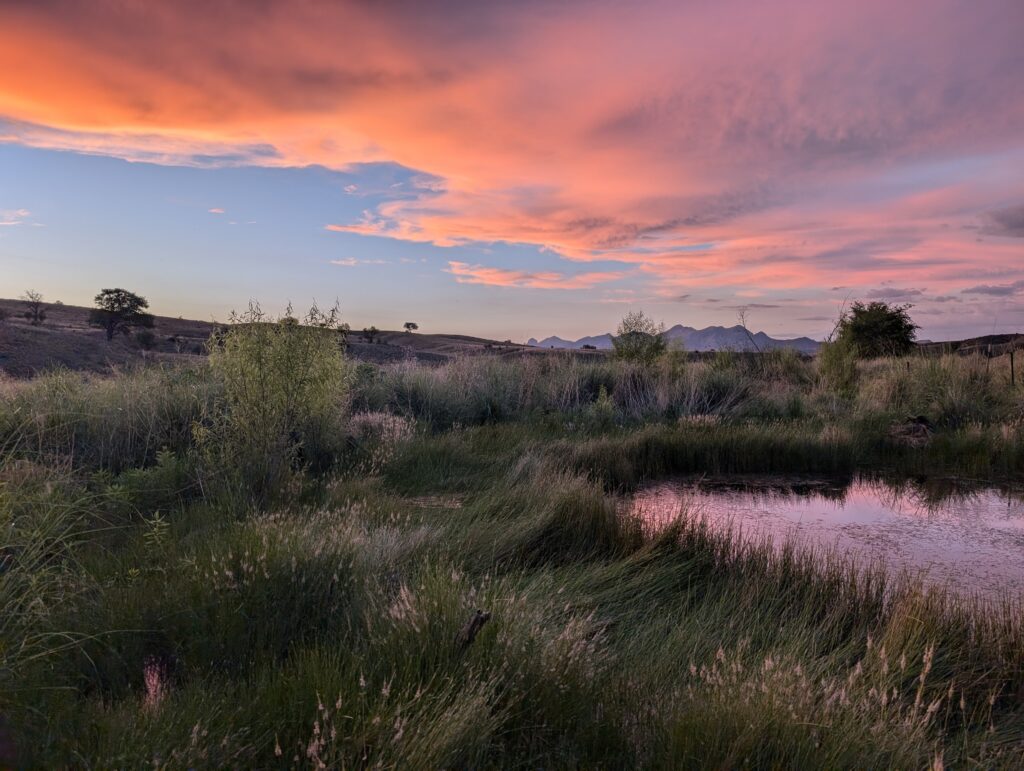

It is 7:16pm and I am crouched next to a small pond, surrounded by bunchgrasses, bulrushes, and sedges. A storm came through earlier this afternoon and the ground is still damp from the rain, the air a bit heavy. I am peering through the sedges along the pond’s edge when I find what I’m looking for: a male Southwest spring firefly, clinging to a blade. Soon, I find another, and then another. Several of them are mouthing the feathery tops of common spikerush (Eleocharis palustris), a behavior I hadn’t noticed before. I’m not sure if they are actually ingesting anything, if they are looking for moisture or nutrients.
It is the height of this species’ activity period. The first flashing firefly to emerge in southern Arizona each summer, the Southwest spring firefly is associated with springs and spring-fed ponds, marshes, and seeps. Adults become active at dusk, with males giving off single green pulses that are repeated every few seconds. On this evening, I see the first flash at 7:30pm, one minute before sunset. Slowly, more flashes ring out around the pond. I watch as individual flashing males move up and down clumps of sedges, pause, and then move to the next clump. They are looking for females. As the sky shifts from coral and salmon to a deepening dark blue, they began moving higher, skimming the tops of the bulrushes. By 8pm, the show is in full force, with over 100 fireflies flying and flashing all around me. It is a thrill every time. In another 15 or 20 minutes they will already be winding down, just a few individuals still twinkling, seeking a female’s response flash from the vegetation. This species rarely flashes more than an hour or so past sunset—ideal for firefly-seekers like me who prefer an earlier bedtime.
This is my second newly documented population of the week, with several more ahead of me. Other Atlas surveyors are having good luck too. At the nearby Coronado National Memorial, biologists doing bat surveys document their first sighting of this species at the park, and two researchers conducting a firefly detection study with trail cameras are uncovering numerous other sites to be checked in future years.
The previous evening, my coworker Saff and I watched a much smaller population sparkle and fade before heading out to look for our second species of the night: the pulsating firefly, Prolutacea pulsator, a rarely seen glow-worm. Barely a mile into our hike up a dirt road on a wind-blasted mesa, Saff spotted something glowing on the ground. We took a closer look. Sure enough, in some stubby grasses just beyond the reach of a harvester ant nest, something is crawling around, green light blazing. We turn on our red headlamps and peer more closely. It’s a glow-worm larva of some kind, and not one we’re familiar with. Could it be our target species? The larva of the pulsating firefly is undescribed. The next day I confer with local firefly expert Joe Cicero, who acknowledges it could be our target, or something else entirely. It’s not possible to know without an adult, but it doesn’t match up with anything he’s seen before, either. Because glow-worms of many species are infrequently encountered, relatively little is known about their life history or juvenile life stages. If you are lucky enough to find a glow-worm—especially a larva or an adult female, both of which are flightless—please post your observation to the Firefly Atlas! Regardless of whether or not your observation can be identified to species, it is really helpful to know where these animals occur, so researchers can return to the site and learn more. At present, all of Arizona’s glow-worms are considered Data Deficient, highlighting the need for more research and surveys on these species.
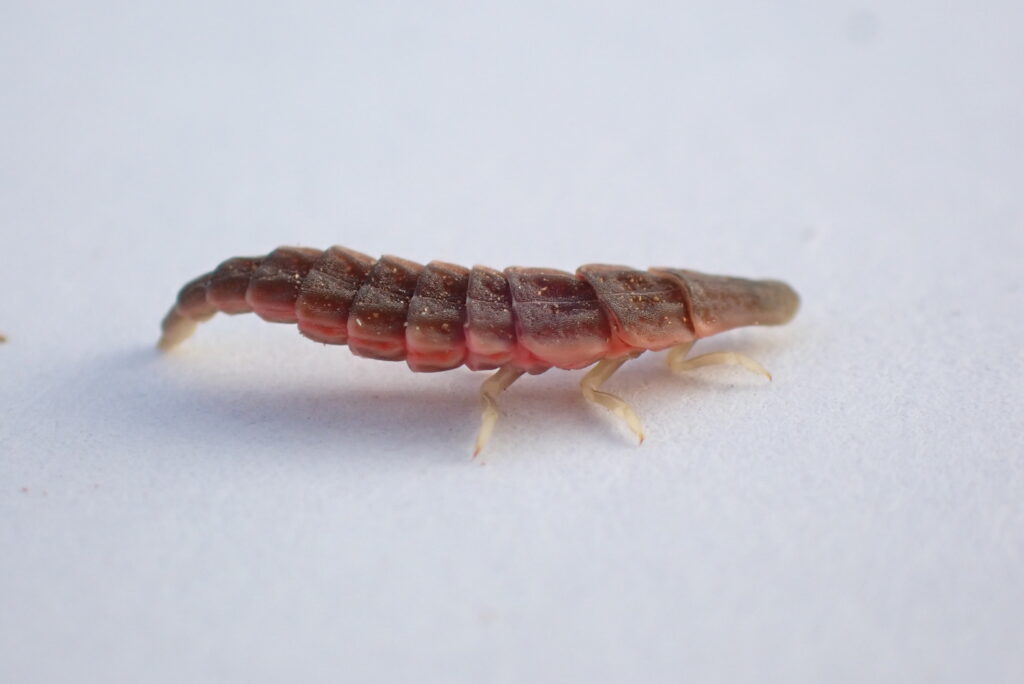
(Photo: Candace Fallon/Xerces Society)

(Photo: Candace Fallon/Xerces Society)
August 2, 2024. Target species: Southwest synchronous firefly (Photinus knulli) and Microphotus glow-worms
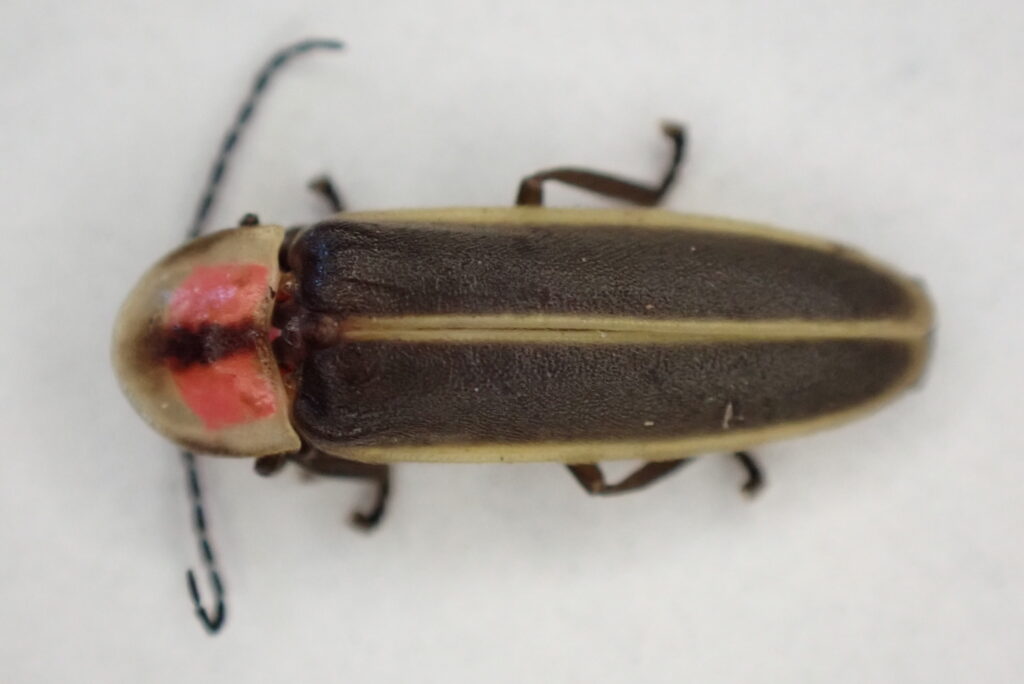

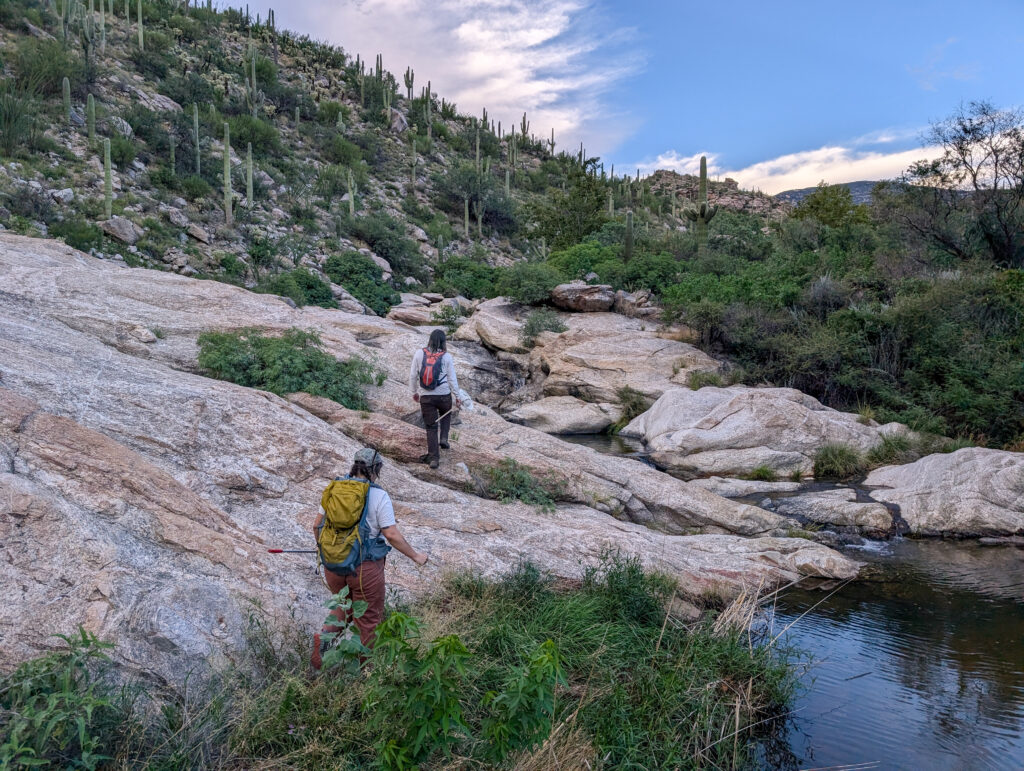

It’s a balmy 90° F and I’m hiking with Saff and a wildlife biologist from Saguaro National Park, looking for a good base from which to do our firefly surveys this evening. We slowly make our way up a drainage pocked by small pools of water overhung with Gooding’s willow, Arizona white oak, ash, and sycamore. Saguaros and ocotillo march up the rocky slopes to either side of us. Our target for the evening is the Southwest synchronous firefly, the second flashing firefly species known to emerge in southern Arizona. This species responds to the monsoon cycle, typically becoming active with the first summer rains in July and sticking around through August or even into September.
While rarely found in large numbers, in some years higher densities of this species can lead males to synchronize their flashes, making the Southwest spring firefly one of only three fireflies in the US known to do so (the others being the synchronous firefly Photinus carolinus and the snappy single sync Photuris frontalis, both found in the eastern US). The Southwest synchronous firefly is smaller than the Southwest spring firefly, and is active later in the evening, after full darkness. It can start flashing about 30 minutes after sunset and continue for several hours if conditions are right. Unlike the Southwest spring firefly, which has a single flash, this species has a triplet flash pattern, although double flashes can also be observed. It is associated with desert canyons and washes, and has been found in some of the same locations as the Southwest spring firefly. Just this year, an Atlas surveyor and firefly researcher has confirmed it co-occurs at sites in Patagonia and the Muleshoe Ranch Cooperative Management Area east of Tucson.
Earlier this summer, the Southwest synchronous firefly was reported from Saguaro National Park for the very first time. Our small team is hoping to find a few more sites in and adjacent to the park, an effort which proves to be successful over the coming evenings. With all the monsoon rain, it seems to be a good year for finding new populations, and reports of other sightings are trickling in. Still, many of these populations appear to be quite small. The greatest numbers recorded in recent years have been from Tumacácori National Historical Park, which now hosts an annual viewing event so visitors can see this phenomenon up close and learn more about this species.
LINK: Reported
On this particular evening in the park, we spot just one adult male Southwest synchronous firefly along the edge of the creek. He flashes sporadically throughout our survey period, without any responses that we can detect. No other flashing fireflies are observed, but we do luck out with two other firefly species – a large and brilliantly glowing larva of the black-winged firefly (Pleotomus nigripennis) clambering on some hillside rocks and scores of tiny adult male dilated glow-worms (Microphotus dilatatus), which flock to our red headlamps when we turn them on to take notes.
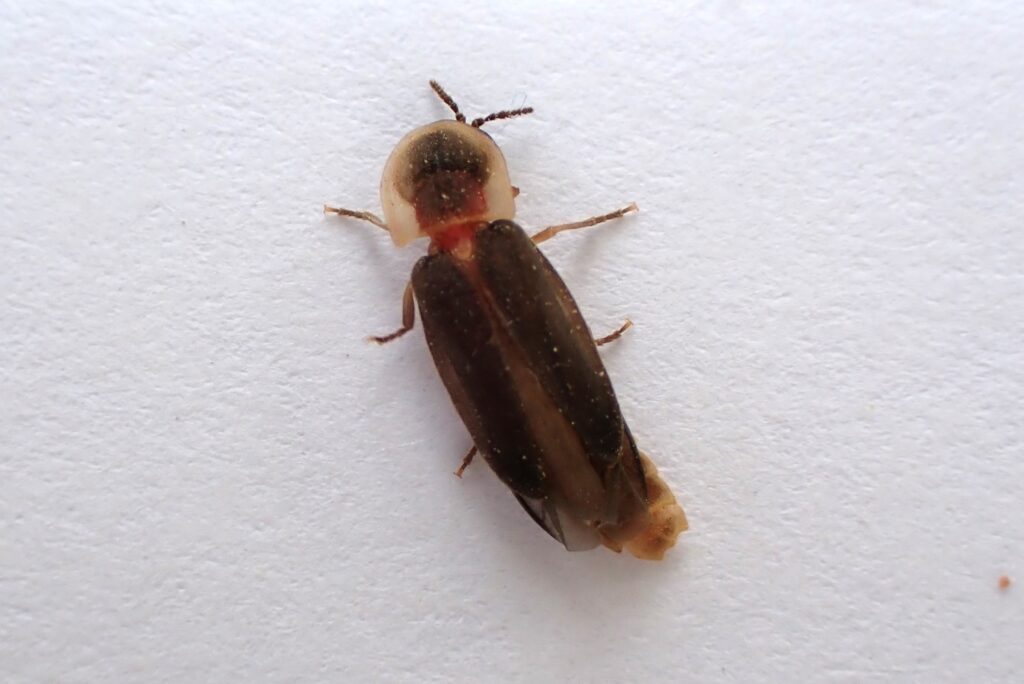

An adult male dilated glow-worm (Microphotus dilatatus) from the Dragoon Mountains. This species was also seen during surveys in Saguaro National Park. (Photo: Candace Fallon/Xerces Society)
Unlike flashing fireflies, most adult male glow-worms do not bioluminesce, but instead have enormous eyes that they use to find glowing flightless females that are perched on the ground. Despite the males’ lack of a lantern, the dilated glow-worm may be one of the most commonly encountered adult glow-worm species in southern Arizona since it readily comes to light. But patience and dark skies can pay off for finding less common species—in the right place, at the right time of night, you might be surprised at what you can find.
Looking ahead
As we wrap up our field season and data entry for the year, we look forward to seeing what other discoveries have been made by Firefly Atlas participants. Whether you made a casual observation of a firefly this summer or did a full survey, we encourage you to report your findings! Together, we’re slowly filling in the gaps on the map for many of these elusive firefly species.
LINK: Report your findings
LINK: Map
Notice: Below is a list of 5 important links included on this page.
3. Reported
5. Map
Please note that while screen readers have made significant strides, they may still lack full support for optimal web accessibility.
By Candace Fallon, Senior Endangered Species Conservation Biologist
Whenever someone asks me why I’m visiting southern Arizona in the summer, and I tell them it’s for firefly surveys, they look at me blankly. Fireflies? Here? No way. In the desert? No. East Coast, sure. Midwest, absolutely. But Arizona?
Perhaps Arizona is not the first place that pops into your mind when you think of fireflies, either. But there are actually quite a few populations of firefly species scattered throughout the state’s deserts, grasslands, shrublands, wetlands, streams, and woodlands. In total, nearly 20 species have been documented from the state, including not just day-active fireflies and glow-worms, but flashing species as well. This is the part that stuns most people: flashing fireflies are very much a part of Arizona’s wildlife—you just need to be at the right place at the right time to see them.

To be fair, even firefly researchers didn’t realize how widespread some of these species were until relatively recently. When Xerces and our partners published the first North American firefly IUCN Red List assessments (a process that helps us determine each species’ extinction risk) in 2021, we had limited information on many species’ distributions, life histories, activity periods, population statuses, and threats. Using what we did know, we concluded that at least two Arizona species were threatened with extinction (including one with two threatened subspecies) and two appeared to be stable. The rest were all categorized as Data Deficient, meaning we didn’t have enough information to accurately assess their risk. However, we suspect that several of these are also imperiled, and will be categorized as threatened in the future.
This pattern of data deficiency is not unique to Arizona – a similar scenario played out over many other states, especially in the West. It’s a large part of why we launched the Firefly Atlas, so we could begin to fill in the gaps in our knowledge, and gain a better understanding of where these species occurred on the landscape. If you have done Atlas surveys in Arizona, you’ll know that the southern part of the state is a focal region for the project, centered on three species in particular: the Southwest spring and Southwest synchronous fireflies (both considered threatened) and the twice-wounded firefly, a day-active species that we know very little about but suspect is threatened. In addition to these, we continue to search for a number of other data deficient species, such as Microphotus and Prolutacea glow-worms.
For the last three summers, I’ve had the opportunity to return to the desert Southwest to search for some of these species. While every trip is different, one thing has remained the same: there is a lot to discover in Arizona, and there’s a growing community of firefly enthusiasts and conservationists that is helping to lead the charge. Here are just a few highlights from the 2024 field season.
July 3, 2024. Target species: Southwest spring firefly (Bicellonycha wickershamorum) and pulsating firefly (Prolutacea pulsator)


It is 7:16pm and I am crouched next to a small pond, surrounded by bunchgrasses, bulrushes, and sedges. A storm came through earlier this afternoon and the ground is still damp from the rain, the air a bit heavy. I am peering through the sedges along the pond’s edge when I find what I’m looking for: a male Southwest spring firefly, clinging to a blade. Soon, I find another, and then another. Several of them are mouthing the feathery tops of common spikerush (Eleocharis palustris), a behavior I hadn’t noticed before. I’m not sure if they are actually ingesting anything, if they are looking for moisture or nutrients.
It is the height of this species’ activity period. The first flashing firefly to emerge in southern Arizona each summer, the Southwest spring firefly is associated with springs and spring-fed ponds, marshes, and seeps. Adults become active at dusk, with males giving off single green pulses that are repeated every few seconds. On this evening, I see the first flash at 7:30pm, one minute before sunset. Slowly, more flashes ring out around the pond. I watch as individual flashing males move up and down clumps of sedges, pause, and then move to the next clump. They are looking for females. As the sky shifts from coral and salmon to a deepening dark blue, they began moving higher, skimming the tops of the bulrushes. By 8pm, the show is in full force, with over 100 fireflies flying and flashing all around me. It is a thrill every time. In another 15 or 20 minutes they will already be winding down, just a few individuals still twinkling, seeking a female’s response flash from the vegetation. This species rarely flashes more than an hour or so past sunset—ideal for firefly-seekers like me who prefer an earlier bedtime.
This is my second newly documented population of the week, with several more ahead of me. Other Atlas surveyors are having good luck too. At the nearby Coronado National Memorial, biologists doing bat surveys document their first sighting of this species at the park, and two researchers conducting a firefly detection study with trail cameras are uncovering numerous other sites to be checked in future years.
The previous evening, my coworker Saff and I watched a much smaller population sparkle and fade before heading out to look for our second species of the night: the pulsating firefly, Prolutacea pulsator, a rarely seen glow-worm. Barely a mile into our hike up a dirt road on a wind-blasted mesa, Saff spotted something glowing on the ground. We took a closer look. Sure enough, in some stubby grasses just beyond the reach of a harvester ant nest, something is crawling around, green light blazing. We turn on our red headlamps and peer more closely. It’s a glow-worm larva of some kind, and not one we’re familiar with. Could it be our target species? The larva of the pulsating firefly is undescribed. The next day I confer with local firefly expert Joe Cicero, who acknowledges it could be our target, or something else entirely. It’s not possible to know without an adult, but it doesn’t match up with anything he’s seen before, either. Because glow-worms of many species are infrequently encountered, relatively little is known about their life history or juvenile life stages. If you are lucky enough to find a glow-worm—especially a larva or an adult female, both of which are flightless—please post your observation to the Firefly Atlas! Regardless of whether or not your observation can be identified to species, it is really helpful to know where these animals occur, so researchers can return to the site and learn more. At present, all of Arizona’s glow-worms are considered Data Deficient, highlighting the need for more research and surveys on these species.

(Photo: Candace Fallon/Xerces Society)
August 2, 2024. Target species: Southwest synchronous firefly (Photinus knulli) and Microphotus glow-worms


It’s a balmy 90° F and I’m hiking with Saff and a wildlife biologist from Saguaro National Park, looking for a good base from which to do our firefly surveys this evening. We slowly make our way up a drainage pocked by small pools of water overhung with Gooding’s willow, Arizona white oak, ash, and sycamore. Saguaros and ocotillo march up the rocky slopes to either side of us. Our target for the evening is the Southwest synchronous firefly, the second flashing firefly species known to emerge in southern Arizona. This species responds to the monsoon cycle, typically becoming active with the first summer rains in July and sticking around through August or even into September.
While rarely found in large numbers, in some years higher densities of this species can lead males to synchronize their flashes, making the Southwest spring firefly one of only three fireflies in the US known to do so (the others being the synchronous firefly Photinus carolinus and the snappy single sync Photuris frontalis, both found in the eastern US). The Southwest synchronous firefly is smaller than the Southwest spring firefly, and is active later in the evening, after full darkness. It can start flashing about 30 minutes after sunset and continue for several hours if conditions are right. Unlike the Southwest spring firefly, which has a single flash, this species has a triplet flash pattern, although double flashes can also be observed. It is associated with desert canyons and washes, and has been found in some of the same locations as the Southwest spring firefly. Just this year, an Atlas surveyor and firefly researcher has confirmed it co-occurs at sites in Patagonia and the Muleshoe Ranch Cooperative Management Area east of Tucson.
Earlier this summer, the Southwest synchronous firefly was reported from Saguaro National Park for the very first time. Our small team is hoping to find a few more sites in and adjacent to the park, an effort which proves to be successful over the coming evenings. With all the monsoon rain, it seems to be a good year for finding new populations, and reports of other sightings are trickling in. Still, many of these populations appear to be quite small. The greatest numbers recorded in recent years have been from Tumacácori National Historical Park, which now hosts an annual viewing event so visitors can see this phenomenon up close and learn more about this species.
On this particular evening in the park, we spot just one adult male Southwest synchronous firefly along the edge of the creek. He flashes sporadically throughout our survey period, without any responses that we can detect. No other flashing fireflies are observed, but we do luck out with two other firefly species – a large and brilliantly glowing larva of the black-winged firefly (Pleotomus nigripennis) clambering on some hillside rocks and scores of tiny adult male dilated glow-worms (Microphotus dilatatus), which flock to our red headlamps when we turn them on to take notes.

An adult male dilated glow-worm (Microphotus dilatatus) from the Dragoon Mountains. This species was also seen during surveys in Saguaro National Park. (Photo: Candace Fallon/Xerces Society)
Unlike flashing fireflies, most adult male glow-worms do not bioluminesce, but instead have enormous eyes that they use to find glowing flightless females that are perched on the ground. Despite the males’ lack of a lantern, the dilated glow-worm may be one of the most commonly encountered adult glow-worm species in southern Arizona since it readily comes to light. But patience and dark skies can pay off for finding less common species—in the right place, at the right time of night, you might be surprised at what you can find.
Looking ahead
As we wrap up our field season and data entry for the year, we look forward to seeing what other discoveries have been made by Firefly Atlas participants. Whether you made a casual observation of a firefly this summer or did a full survey, we encourage you to report your findings! Together, we’re slowly filling in the gaps on the map for many of these elusive firefly species.



